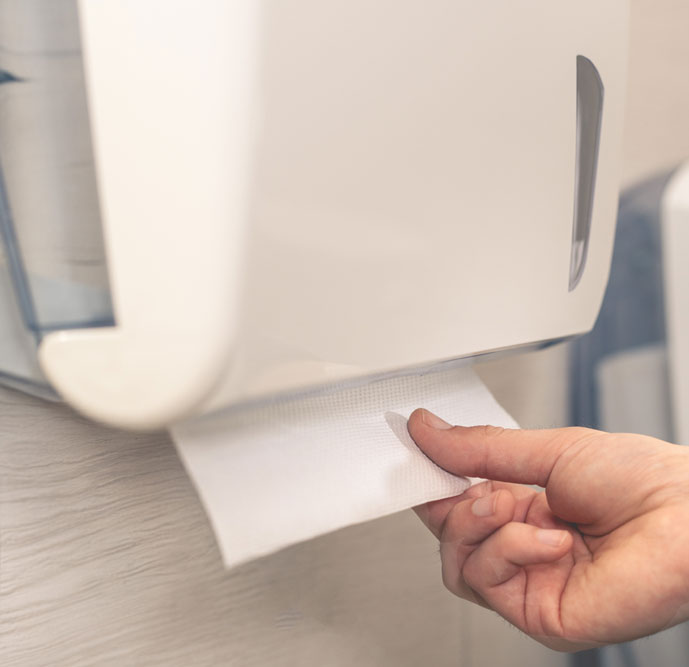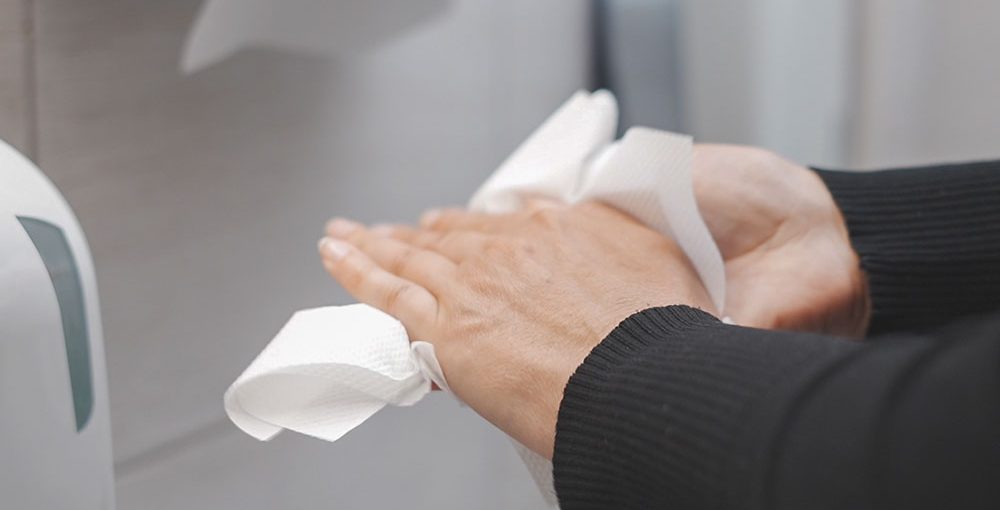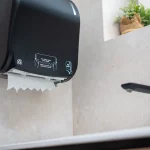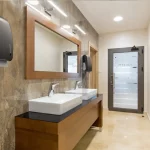Paper packaging price – In a market where consumable prices fluctuate frequently and budgets are getting tighter, paper packaging remains an expense that’s often taken for granted—until it starts becoming a problem.
Excessive usage, wrong formats, dispensers that waste instead of saving—all dismissed with a casual “it’s just paper towels and toilet paper.” But within that “just” lies the potential for savings—or unnecessary loss.
In this blog, we break down what actually goes into the price of paper packaging, how to assess the cost-effectiveness of different formats, and why the price per sheet isn’t the same as the price per user. Especially if you’re responsible for offices, high-traffic facilities, or work zones where hygiene must be consistent and budgets must stay in check.
Related topic: Paper hand towels
Find out how to choose the right towel for your business needs. Call us or check our offer online +381 66 811 83 82.
What makes up the price of paper packaging when we say “Paper packaging price”?
Most people think of toilet paper or hand towels.
But the price structure is much broader—here’s what to consider:
-
Raw Material
Is the paper made from virgin pulp, recycled fibers, or a combination? Virgin pulp is more expensive, but softer and more absorbent. Recycled paper is more affordable but requires a better dispenser to avoid waste. -
Number of Plies
Two-ply paper is the standard for budget-controlled facilities, while three-ply and four-ply offer a more luxurious feel and lower usage per person. -
Fold Type or Format
Z-fold, V-fold, jumbo rolls, mini jumbo, industrial rolls—each has a different price per sheet and performs differently in practice. -
Packaging and Transport
Large facilities often buy jumbo packs or pallet-sized rolls. But if storage space isn’t optimized, the costs can quickly rise. -
Dispensers
A good dispenser is your cost-saving ally. A bad one leads to waste.
The price isn’t the number on the invoice—it’s the sum of all the above.
Related topic: Toilet paper dispensers and the moment of truth
Learn how the right dispenser can radically change your consumption. Contact us for a model recommendation tailored to your facility: +381 66 811 83 82.

Common mistakes that increase costs without you noticing – Make smarter choices when searching “Paper packaging”
-
Buying by the sheet, not by the function
It may sound odd, but paper is often purchased by the sheet—not by what that sheet is supposed to do: dry hands, provide a sense of cleanliness, leave no residue. In facilities where people need to take four sheets to do what one high-quality sheet could, costs quickly rise. That’s why premium three- or four-ply paper, although more expensive per sheet, often reduces overall usage and pays off in the long run. -
Mixing formats
When you have Z-fold towels in one stall and a roll dispenser in another, staff often makes mistakes during refills. Towels jam, users pull too much, or get frustrated. Standardizing formats reduces waste, speeds up restocking, and lowers costs. -
Misjudging the number of users
If the toilet is used by employees, clients, and external visitors, but you’re ordering supplies as if it’s only for staff, you’ll end up making urgent, last-minute purchases—which are always the most expensive. Accurate traffic tracking is the foundation of a proper procurement plan. -
Too high or too low paper weight (grammage)
In an office, you don’t need industrial-strength paper—but a thin toilet paper won’t work in a workshop either. The wrong grammage means either too much use or user dissatisfaction. The ideal price is when the paper does its job using as few sheets as possible. -
Mismatch between dispensers and paper format
When a dispenser isn’t compatible with the paper inside, it causes jams, double pulls, and frustrated users. A good dispenser doesn’t have to be expensive—but it must match the paper format.
Related topic: Liquid soap dispensers – The perfect blend of function and design
Check out our selection of dispensers to stop waste at the source, or contact us for more information: +381 66 811 83 82.
Comparing the price of paper packaging per sheet vs. per use
This difference is crucial.
A paper that costs 0.002 dinars per sheet, but requires five sheets to dry your hands, is actually more expensive than one that costs 0.005 dinars and absorbs on the first try.
That’s why a smart calculation includes:
- Average number of sheets per user
- How long a roll or pack lasts in practice
- How often it needs to be refilled
- Cost of refilling and maintenance
What you need is the price of paper packaging per use, not per package.
Three paper packaging tiers you should know about:
-
Economy Two-Ply (Recycled Paper)
-
Price: Lowest
-
Ideal for: Schools, gas stations, warehouses
-
Savings: Low cost per sheet, but higher number of sheets per use
-
Note: Requires a quality dispenser to prevent waste from double pulling
-
-
Balanced Three-Ply (Cellulose + Softness)
-
Price: Medium
-
Ideal for: Offices, clinics, mid-range hotels
-
Savings: Fewer sheets needed, better user experience
-
Note: The most common choice when seeking value for money
-
-
Premium Multi-Ply (Four-Ply, with Micro-Perforations)
-
Price: Higher
-
Ideal for: Executive floors, lounge areas, high-end hotels
-
Savings: Reduced consumption, enhanced brand impression
-
Note: Best used where experience matters more than just function
-
Related topice: Why are Z-fold paper towels the choice of establishments that know what they’re doing?
Discover how Z-fold towels reduce waste and increase effectiveness—contact us or explore our range at +381 66 811 83 82.

“Paper packaging” often seems insignificant – But this is exactly where you may be losing money without noticing
-
Overstocking
Cardboard packaging deteriorates, paper gets deformed, and part of the inventory is thrown away. -
Uncoordinated Deliveries
You end up paying for express shipping or making off-system purchases. -
No Standardization
Each facility uses a different system, which complicates procurement and increases the chance of errors. -
Lack of Staff Training
Employees don’t know which towel goes where, so they just use whatever is within reach. -
No Consumption Monitoring
If you don’t know how much Department A uses compared to Department B, you can’t plan properly. -
Unplanned Ordering
If restocking is done randomly, it leads to duplicate stock and extra costs.
How to Know If Your Price Is Truly Optimal? Ask Yourself These 5 Questions:
- Do you know the exact number of people using the toilet daily?
- Do your rolls or packs last as long as the manufacturer claims?
- Do you have a standardized format across all locations?
- Do you experience emergency purchases or “improvised” solutions?
- Do you know your actual cost per usage?
If you don’t know the answer to more than two of these questions, you’re probably paying more than you think.
That’s why we’re here – to take care of everything for you. Contact us now: +381 66 811 83 82.
The question of “paper packaging price” isn’t just about how much you spend on toilet paper and paper towels. It reveals whether you have a well-organized system—or rely on improvisation. When paper runs out, when a sheet doesn’t do its job, or when inventory doesn’t match actual usage, it’s not a logistical hiccup—it’s a sign that something deeper isn’t working.
In companies where paper usage is organized, predictable, and under control, costs go down while standards go up. When you know exactly what format you need, how many sheets users typically take, how long the packaging lasts, and how to avoid incorrect refills—you have a system that saves money, time, and effort.
On the other hand, when there’s no standard, when refills happen “whenever someone remembers,” and there’s no clear consumption tracking, you face a higher risk of emergency costs, excessive stock, user frustration, and a poorer impression of your facility.
Managing paper is the same as managing space. When you know where, when, and how it’s being used, you can easily plan ahead, adjust for seasonal needs, evaluate efficiency, and maintain a professional level. If you don’t—you’re likely paying more than you think and getting less than you expect.
That’s why “paper packaging price?” is a question you should ask before your next order. Not because of the price per sheet, but because of the overall impression your space gives to everyone who walks in.
If you’re aiming for order, efficiency, and savings—paper is the right place to start. Because it’s often the quickest way to see whether a company is running smoothly—or just getting by.
Want more insights like this—tips that cut costs and raise standards?
Sign up for our newsletter to receive real-world insights, product comparisons, and expert recommendations from the world of hygiene solutions—no ads, no fluff. Just practical advice that helps you save money and take control.





